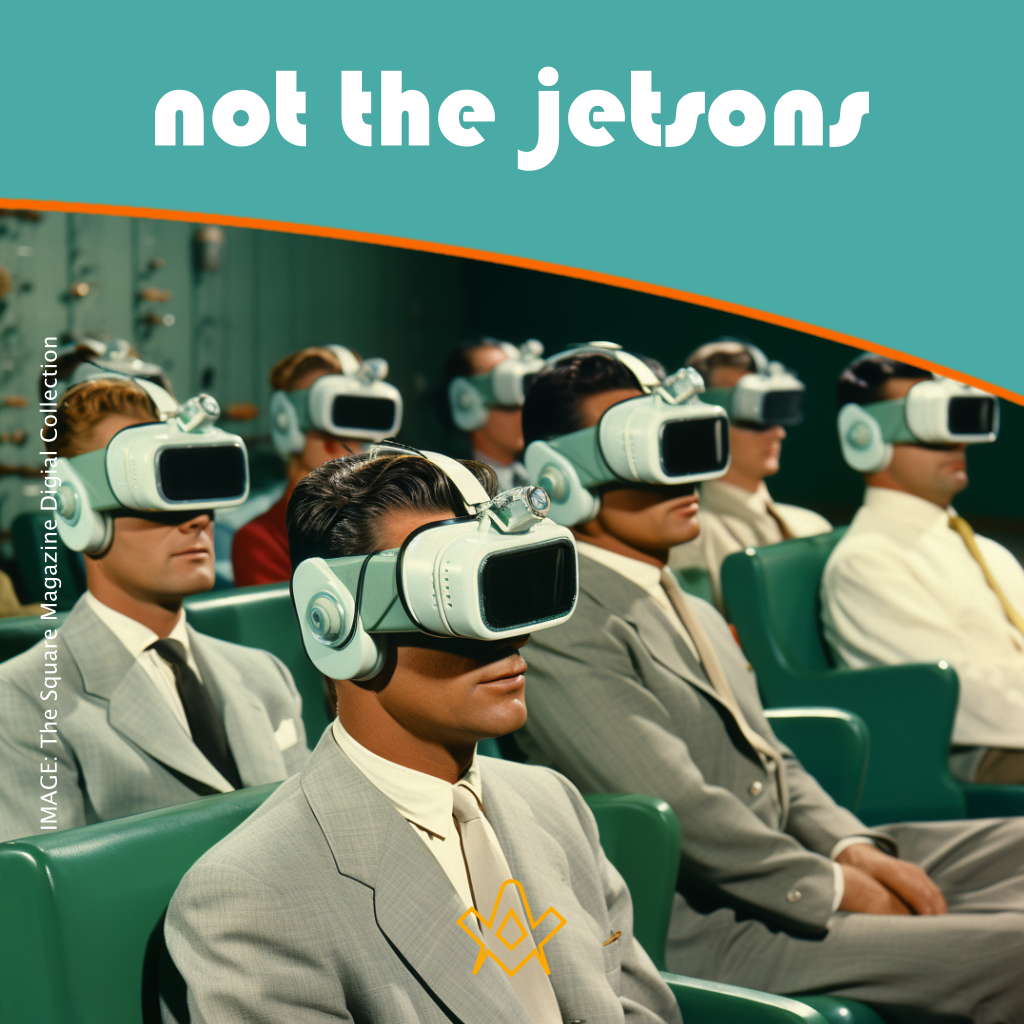The article explores using Virtual Reality (VR) for Masonic rituals, offering immersive experiences beyond traditional methods.
While VR ensures consistent quality and flexibility, it might reduce group interactions.
The author suggests Masonic bodies consider VR for specific rituals, highlighting its future potential.
Not the Jetsons: Use of a Fully Immersive Experience For Transmitting and Conferring Degree into the Future.
— V. Ven. Bro Scott Wisdahl
![]()
Reality is merely an illusion, albeit a very persistent one
– Albert Einstein
Anyone who has had the opportunity to go through a well executed initiatic experience will understand that it was more than simply the attendance at a meeting.
Very Venerable Brother Chris Lirette explored some of the physiological aspects of ritual in a paper called “Betwixt and Between, the Role of Ritual in Esoteric Societies” [2].
He explored the stages of ritual and highlighted the impact on the individual.
Those that have been through these initiatic experiences who are Masons have likely also experienced rituals or ceremonies that were lacking in the this physiological impact. This may have been due to the setting, or how the ritual was presented, or the abilities of the presenters.
Some rituals are more profound than others. Some are simply a form of education. One could segregate them into “transmissions” and “conferrals” of degrees [3]. The goal would always be to make the experience as personally impactful and valuable as possible.
Traditionally rituals, or degrees, are presented in a dedicated space by members of the group the candidate is aspiring to join. Using Masonry as an example, most degrees or rituals are conducted in dedicated rooms (Lodge Rooms) by Masons who have previously gone through the degree [4].
There are a number of elements used in the ritual the largest being a series of lectures or phrases and words given by one or more Masons. Other elements would include some form or movement around the room (known as ‘floor work’), and some simple props. The candidate may be clothed differently.
In some Orders the speaking parts are memorized (known as ‘memory work’) while in others it is either acceptable or required to be read from a ritual book. Memory work is expected to be delivered word for word as it had been presented before. Often the reason the work is expected to be read is so that the words are not mixed up or changed.
When the person delivering the work has not fully memorized it, they are then prompted so that they can deliver the work. Other times, the person who is expected to read the work, hasn’t taken the time to have read it ahead of time, so they miss the timing and presentation of the work.
One reason a degree might not be as meaningful to the candidate may be because of the poor memorization or presentation by the speaker. In some cases, the presenter has the work ‘word perfect’ but delivers it in either a monotone or so rapidly, the candidate gets almost nothing from it.
In Masonry it is often said that one doesn’t understand the degree they have gone through until they have watched someone else going through it. They won’t really understand it, until they have had to deliver the work themselves.
The props used in the degree, often referred to as symbolic elements are aids to the degree. They may visually present the lecture (tracing boards) or reflect some part of the story. In most cases the candidate is expected to use their imagination to visualize what is being presented, hopefully with the assistance of someone orally describing the situation.
If one moves past the ‘its always been done that way’ argument, is it not possible that there could be a different way of delivering a degree?
A few short years ago the concept of an artificial environment that could be realistic to the participant would seem crazy; something that should be confined to the concepts of the holo-deck of the Star Trek series. Technology especially processing power has changed this completely. Recent advances in Virtual Reality (‘VR’) point to what will be available in a few years.
“VR broadly refers to immersing yourself in a three-dimensional (3D) digital world using sophisticated hardware and software.” [5]
Today it is possible to play sophisticated games at home or at entertainment centres using headsets, headphones and perhaps props (things the person handles).
How could VR be used to deliver Masonic degrees?
The candidate would wear some form of goggle and headphones. These would severely restrict their ability to see anything around (i.e. reality) or hear anything. What the candidate sees and hears is completely controlled.
If the degree expected the candidate to be blindfolded, then there goggles would show nothing (or perhaps just small flashes of light as would be ‘seen’ when wearing a blindfold).
What the candidate hears would be the ‘memory work’ that has been previously recorded by someone with feeling and presence. The candidate could be moved around a room to simulate floor work.
If the candidate is expected to see something, they could see a high quality image of that item, but better yet, images of the surrounding. That could be a Lodge Room or it could be something else.
For one example: perhaps the candidate can ‘look’ around and see that they are in the quarries with workman preparing materials for King Solomon’s Temple. In another example, they could look down and see that they were wearing armour, or maybe are dressed in tattered and dirty clothes.
The lectures could be delivered with images of the presenter, or simply played out like a movie. The candidate would visually see what was expected to be seen and hear well rehearsed and presented commentary. They could answer questions put to them. They could ‘look’ around them and see other aspects of the degree.
Imagining this future, these VR degrees would be produced by larger organizations for use by their members. No secrets would need to be shared outside of the group if they worked with Mason artists and technicians. He best possible presenters could be used so that spoken word was the best possible. No more prompters, no more flubbed lines.
The immersive experience would be improved by use of some props that could be placed onto the candidate to produce a tactile response.
The candidate might be bare footed. It would be possible to use some very simple fans to produce a virtual wind if that was necessary and the use of things like incense or simply aromatics (think of something like a more pleasant-smelling salt) would add to the olfactory sense.
The candidate would need to be guided. This is where a more human side would come into play. The conductor would physically guide the candidate and would be monitoring the ‘story’ (presentation of the degree). They would have a microphone that could be used to speak to the candidate if necessary.
They could have a simple control device to stop the speaking part of visual story if necessary. The conductor would be the person who would take the responses of the candidate and if necessary end the session (i.e. the candidate doesn’t take an obligation).
There is no reason to assume that this would be done outside the control of Masonic organizations. The actual degrees (the presentations) should be controlled by the appropriate Masonic body and only presented to approved candidates, an then only under the control of someone authorized by that Masonic body.
Using AMD as an example. Only a Brother of St Lawrence could be candidate for the virtual presentation of the Knight of the Red Branch of Eri.
The candidate would only go through this virtual presentation when in the presence and control of an Installed Sovereign Master when authorized by however the Grand Council would control it.
There could be a separate Conductor or other assistants. The candidate would have been approved and would go through the degree in somewhere private.
There are a number of advantages of this approach. One obvious one is that the quality would be consistent across the Masonic organization and could be done to a high level of quality by using the best visual and oral recordings.
Another advantage of this concept is that the quality and presentation should be such that the candidate can understand it the first time they go through it. By using VR all that is required is that a private rom be available that has some size to allow for moving around.
This means that a Masonic organization would not be tied to a particular building. This would allow the use of something like a rented meeting room.
The decoupling of a specific location and the requirement for potentially a number of members to present the degree would allow the degree to be presented essentially anywhere and at a time that would be easier to arrange: the candidate, the person controlling the degree and perhaps some assistants are all that would have to coordinate their schedules.
Important elements of initiatic experiences could remain. The sense of anticipation and of being out of their comfort zone could be brought to bare. It would not be difficult to prepare something like a room of reflection or require a period of quite meditation. In fact, this might heighten the experience.
There are elements that are lost by this approach. Only a select number of members would end up performing rituals, so the opportunity to be a ritualist would be minimized. This might also reduce learning, as one way to learn a subject is to ‘teach’ or present it.
Additionally, there would be a loss of being part of a group and of the group seeing the candidate.
These could be overcome by ideas like having the members assembled to watch the degree, perhaps with monitors displaying what the candidate sees (this is done at VR ‘arcades’ now).
When the degree is done, the members be there to welcome the candidate and education could then be scheduled to go over the elements of the degree just presented.
The concept of VR would require the cooperation of multiple Masonic organizations to afford the productions. New governance would be needed to control how the degrees were made available.
Cooperation among local groups would be needed to share in the costs of the equipment. These sound exactly like the reason for having larger Masonic control organizations.
Masonic organizations should start exploring these concepts now for use with less critical rituals (i.e. those referred to as ‘conferred’ degrees) and begin the thought process on how to make this work.
There are great opportunities available to deliver impressive initiatic experiences and great Masonic education to a whole new generation of people.
Footnotes
References
[1] This is planned to be the first in a number of papers exploring possible future Masonic situations. It is not a recommendation of changes to be made today but rather as an exercise in the ‘possible’.
[2] Chris Lirette “Betwixt and Between, the Role of Ritual in Esoteric Societies” Transactions of the SRIA Province of British Columbia & Yukon 2018 (SRIA Province of BC and Yukon, 2018) p 219.
[3] Taken from a paper by Scott Wisdahl “A rose by any other name may not be the same: A critical examination of degree conferral and transmission”, The Architect, 2021 (Grand Council of Allied Masonic Degrees Canada, 2021) p64.
[4] There are, of course, degrees and rituals that can be conducted by those who have not been through the degree first. In the Allied masonic Degrees and example of this would be the Masters of Tyre degree.
[5] Logan Kugler “The State of Virtual Reality Hardware” (Communications of the ACM, February 2021, Vol. 64 No. 2) p 15-16.
Article by: Scott Wisdahl
RWBro. Scott Wisdahl
Junior Warden, Fort St. John Masonic Lodge No. 131. Grand Lodge of BC & Yukon
Articles by Others: VR/AR/AI metaverse freemasonry
 The Great Algorithm of the Universe Explore the algorithmic essence of the Universe, from complex to simple and back again. Dive into the stochasticity of nature, the organic and inorganic omniverse, and the unexpected excellence of algorithmic data. Discover how repetitive processes yield extraordinary exceptions, much like the historic publication of the freemason’s constitutions. |
 Building a 21st Century Freemasonry Legacy: Freemasonry, rooted in the Middle Ages, values knowledge, equality, and fraternity. This article examines its historical influence on science and peace and its potential to continue this role. Understanding Freemasonry's relationship with science and peace is crucial for contributing to a fair, peaceful, and multipolar contemporary world. |
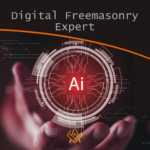 In the ever-evolving world of technology, artificial intelligence (AI) has revolutionized various industries, and now it's making its mark on Freemasonry. The Official Digital Freemasonry Community (ODFC) has introduced the "Digital Freemasonry Expert" AI tool, which aims to provide Masonic members with quick and accurate access to information, historical facts, and answers to their burning questions. This groundbreaking tool not only enhances the Masonic experience but also encourages dialogue and a deeper understanding of Masonic heritage. Join ODFC in embracing the digital transformation of Freemasonry and paving the way for innovation. |
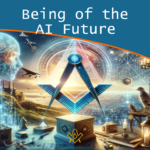 Being of the AI Future: Reflecting on the Knowledge of the Self Being of the AI Future; critically examines the shift from traditional power dynamics to data control in the AI era. It challenges us to rethink evolution and self-identity amidst AI's rise, highlighting Freemasonry's role and the need to balance technological progress with preserving human values. |
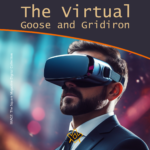 The Virtual Goose and Gridiron In a digital era where virtual reality blurs the lines between the tangible and the intangible, Masonry explores the metaverse. Here, a Masonic Hall stands grand in the virtual expanse, its public symbols beckoning seekers and brethren alike. Within, curated materials and private chambers offer knowledge and connection, transcending physical limits. |
 Freemasonry and Generative AI – Part 2 Freemasonry meets Generative AI: Dive into the profound intersection of ancient Masonic principles and cutting-edge artificial intelligence. Explore the ethical conundrums, ontological debates, and the evolving role of AI in Masonic traditions. Will Brother AI soon join the Masonic ranks? A must-read for tech enthusiasts and Freemasons alike. |
 The article explores using Virtual Reality (VR) for Masonic rituals, offering immersive experiences beyond traditional methods. While VR ensures consistent quality and flexibility, it might reduce group interactions. The author suggests Masonic bodies consider VR for specific rituals, highlighting its future potential. |
 Venturing into the Virtual Lodge: A Revolutionary Approach to Freemasonry Unlock the celestial secrets of Freemasonry! Discover how Masonic rituals transcend physical boundaries, reaching for the stars in a VR space. Join us on a cosmic journey, where ancient traditions meet cutting-edge technology under the watchful eye of the comet above. The future of Freemasonry is here! |
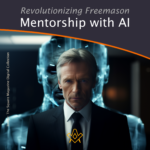 Revolutionizing Freemason Mentorship with AI Explore the intricate relationship between Freemasonry and mentorship in this captivating article. Unearth the rich history of this secretive fraternity, the symbol-laden rituals, and the transformative power of mentorship within the brotherhood. Delve into challenges faced and the potential impact of AI on Freemasonry mentorship. Immerse yourself in this intriguing journey! |
 The Future Use of Virtual Reality for Freemasonry Ritual Experience Freemasonry like never before! Dive into our ground-breaking research on harnessing Virtual Reality (VR) for Freemasonry rituals. We're transforming centuries-old traditions into immersive, accessible experiences. Discover how we're bridging the gap between historical symbolism and cutting-edge technology. Join us on this exciting journey into the future of Freemasonry! |
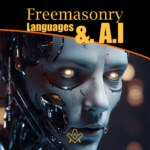 Unlock the enigmatic world of Freemasonry as we delve into its secret language. Explore the fascinating intersection of Generative AI and the Turin Test, unravelling the hidden codes and symbols that have intrigued generations. Discover the mysteries behind this ancient craft in our captivating introductory article. |
 Discover the exciting intersection of Freemasonry and AI. Explore how programming personal AI robots with Masonic principles like brotherly love, relief, and truth can revolutionize our interaction with technology, fostering a more ethical and empathetic AI future. Dive into the world of the Freemason AI robots now! |
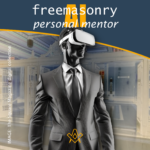 Imagine you are an AI-based personal development coach. Describe a subscription service that leverages cutting-edge technology and behavioural science to help users achieve their personal growth goals. What features would it have, and how would it keep subscribers engaged month after month? |
 Artificial Intelligence and its uses: from Society to Freemasonry Just as AI is not a panacea or a disaster, and the result depends on its use, so its application in Masonry will be beneficial and not counterproductive if the Brothers apply it constructively. By George Thanasoulas |
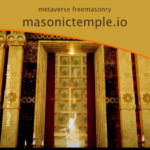 Metaverse freemasonry takes one step closer to become a reality as the Portuguese based company, Skyunicron, show case their Solomon Temple in the metaverse platform, a place for all Freemasons to meet in brotherly love and harmony, which at all times characterises freemasonry. Lets take a short tour….. |
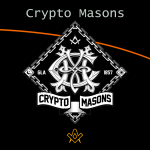 One of the first initiative for Masonic Art NFT collections with philanthropic goals supported by a regular Grand Lodge, in this case, the Great Lodge of Argentina of Free and Accepted Masons. |
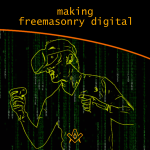 How do we prepare to make Freemasonry digital? Once we strip away the Masonic packaging, we are left with pure Freemasonry, which is not physical but content. |
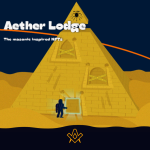 The vision is to satirize the many existing myths and preconceptions about Freemasonry by building a united community around an engaging story with multiple benefits. Aether Lodge consists of 9990 Masonic-themed NFTs divided into multiple collections. |
 What connects Freemasonry and Bitcoin ? Both are misunderstood and ridiculed by the ill-informed. If freemasonry is about being a better citizen of the world. Then Bitcoin is about: making the world a better place for all citizens |
 Metaverses, Masonry and Minecraft: The Future of Lodges Should Freemasons be proud that a clandestine group has borrowed their symbolism and ideology and transplanted it into a server known as ‘The Worst Place in Minecraft’? Metaverses, Masonry and Minecraft: The Future of Lodges |
 Freemasonry and the Metaverse P2 In this second instalment, Freemasonry and the Metaverse. We discusses the importance of being an open source protocol and how could Freemasonry benefit from a metaverse structure? |
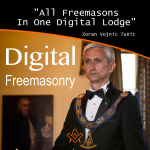 All Freemasons In One Digital Lodge; Is this viable?, is it practical ?, is it even possible ? To answer this question we need to under the problem "Digital Freemasonry" aims to fix. |
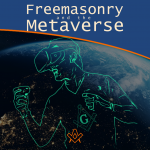 Freemasonry and the Metaverse P1 There is growing interest in the Freemasonry and the Metaverse on social media. Some projects are starting out as Masonic art NFT collections, while others are more clearly see a point in the future where they will be lodges operating in a metaverse. |
 Great Architect of the Metaverse Are you ready to meet in the metaverse ? what can you expect to see and do ? |
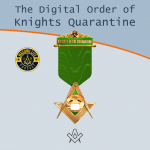 The Digital Order of Knights Quarantine Called “The Digital Order of Knights Quarantine”, it was advertised as “not-a-degree” because it was not an actual degree. |
 What would make a good Masonic phone app? Share one feature you would include in a phone app for Freemasons . . . |
masonic knowledge
to be a better citizen of the world
share the square with two brothers

click image to open email app on mobile device
